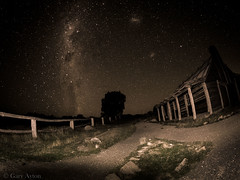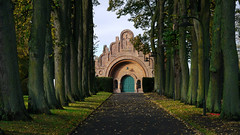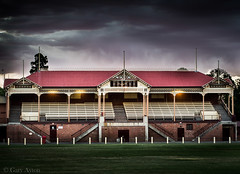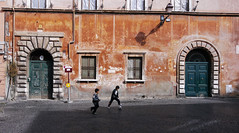I have previously compared the Canon G11 with Olympus E-P1 here.
In June 2009, I decided to buy the Panasonic GH-1 to compliment my Olympus E510+ZD50-200mm lens, and my Canon 1D Mark III system. I chose the GH-1 because it added high quality HD video with full autofocus (the only dSLR-like camera that will do this) and it had a great electronic viewfinder (better than the optical viewfinder of the Olympus E510), the unique 10x high quality kit lens optimised for HD video, and the flip out LCD screen.
The Micro Four Thirds Panasonic GH-1 is a brilliant camera, and the ONLY digital camera with interchangeable lenses that does full AF during HD video. My GH-1 was one of the first available in Australia, and despite firmware updates it does have a few issues – see here (I would recommend extending Panasonic’s 1 year warranty to 3 years because it gives the feeling that one will need it – unlike my Olympus gear so far).
Having said that, the GH-1 has become my main carry around camera kit for taking into the city, to conferences, to social events, on travel, and to work, but one does need an extra lens or two to compliment its 10x kit lens – I would recommend the Panasonic 20mm f/1.7 lens (although I use the much bigger, more expensive Panasonic Leica-D 25mm f/1.4 Four Thirds lens as that was the only one available when I needed it), and perhaps a manual focus 100mm or 135mm f/2.8 prime lens (I use Olympus OM as they are beautifully compact and you can change the aperture). Some may add a 50mm f/1.8 lens as well for portraits, or if they have the money, the MFT Panasonic Leica 45mm f/2.8 macro lens. The forth-coming Olympus MFT 9-18mm lens is likely to be another nice lens to add to your collection.
BUT, many do not wish to go for the SLR-like styling, cost, and marginally larger size of the GH-1, and HD video is not so important to them, so I thought it is time to offer a comparison of features between the models.
Firstly, a few things they have in common:
- no mirror thus smaller and quieter than dSLRs and able to take almost any lens ever made, and no image blurring from mirror vibrations while accurate manual focus anywhere in the frame is much faster.
- 12 megapixel Four Thirds sensor
- 3fps burst rate
- accurate contrast detect autofocus – no need to worry about back focus errors as with dSLRs
- full time live preview with easy manual focus magnification (no need to drop mirror down, etc)
- able to change aperture of Four Thirds lenses, and in some cases also autofocus Four Thirds lenses
- use SD/SDHC memory cards
- hot shoe for external flash and TTL compatible with Four Thirds flashes (and can even use Canon off-camera TTL cord)
- no remote TTL available?
- +/- 3EV exposure compensation
- HDMI out for playback on TVs but not live output
- in general, easier to use than dSLRs
| Olympus E-P2 | Panasonic GF-1 |
Panasonic GH-1 | |||
| dimensions | 121mm (W) x 70mm (H) x 36mm (D) (excluding lens) | 119 x 71 x 36.3 mm |
|
||
| weight with battery | 355g | 315g | 385g | ||
| sensor size | 18.00 x 13.50 mm, 2.43 cm² | same as E-P2 | over-sized to allow for uncropped 16:9 and 3:2 image aspect ratios | ||
| in-built flash | No | Yes 6.5m range | Yes 10m range but shadow with kit lens at 14mm | ||
| flash | sync 1/180th ? can manually force increase for non-TTL external flashes
FP TTL with FL50R and FL36R No built-in flash. Manual flash output settings. TTL flash even with legacy lenses. |
sync 1/160th – no ability to force higher sync
no manual flash output setting built in small flash no TTL flash with legacy lenses other flash issues see here |
sync 1/160th – no ability to force higher sync
no manual flash output setting built-in flash no TTL flash with legacy lenses |
||
| ISO | 100-6400 | 100-3200 | 100-3200 | ||
| image stabilisation | in-camera – works on ALL lenses but not during video | optical in some lenses works during video | optical in some lenses works during video | ||
| movie video modes | 1280 x 720 (30 fps), 640 x 480 (30 fps)
EVF port functions as external mic port as well Must place mode dial in movie mode then start/stop movie using shutter button. No dedicated movie start/stop button. Image stabiliser does not work other than by changing ISO. Can use ART filters. |
1280 x 720 x 30fps (AVCHD, Motion JPEG)
848 x 480, 640 x 480, 320 x 240 (Motion JPEG) Optical image stabiliser in lens works. Can use film modes. Dedicated movie start/stop button. |
1920×1080 AHCHD
1280×720 at 50/60fps AVCHD or motion jpeg smaller sizes motion jpeg stereo mic + ext. mic port Dedicated movie start/stop button – works in any camera mode, but must set mode dial to Custom Movie for manual movie mode. Optical image stabiliser in lens works. Can use film modes. |
||
| LCD | 230,000 dots fixed; Better in sunlight than GF-1; | 460,000 dots fixed; Better low light performance than E-P2; | 460,000 dots swivel | ||
| viewfinder | very high quality clip-on tiltable EVF included
optional optical fixed focal length for 17mm lens |
optional lower quality EVF which attaches to the hotshoe | integrated very high quality EVF | ||
| lens | kit lenses – 14-42mm f/3.5-5.6 and 17mm f/2.8 pancake | 20mm f/1.7 – THE MFT lens to get! | the unique HD video optimised 14-140mm lens – heavy and expensive but the only lens with continuous AF in HD video | ||
| AF issues | slower AF but works with nearly all Four Thirds lenses and AF speed with 20mm f/1.7 is similar to that on GF-1. select AF mode via rear button Can use MF to fine tune AF – just set AF mode to S-AF+MF and after setting AF via half-press shutter (keep it half-pressed though), use other hand to turn lens MF ring. Can use AFL in one touch to set AF in MF mode (use MF mode 3) – a favourite setting of mine! |
faster AF but no AF on most Four Thirds lenses unless they are contrast-detect AF capable
Moving magnified MF area around on the screen is more cumbersome than on the E-P2, but you do get smaller AF area rather than just the 11 larger AF frames as on the E-P2. AF assist lamp (not on E-P2 and must use flash on GH-1). |
faster AF but no AF on most Four Thirds lenses unless they are contrast-detect AF capable
select AF-C, AF-S or MF via lever on top left. Cannot use MF to easily fine tune AF, must move lever to MF to use MF. select AF mode via button on rear. Must move lever to AF then half-press shutter or use AFL button to set AF. |
||
| Auto modes | iAuto – camera automatically selects either Portrait, Landscape, Night Scene, Sport or Macro mode.
Art – use digital art filters such as soft, pinhole, grainy film, pop art, diorama, cross-processing, etc SCN – you select a Scene mode Movie – you can use P, A, M +/- art P, A, S, M exposure modes |
iAuto – camera automatically detects scene mode to use.
Scene modes – night, macro, sports, scenery, portrait, color. SCN – other Scene modes – sunset, party, baby1/2, pet. Custom Movie – allows manual exposure, even shutter speeds as slow as 0.5 sec! CUST – option of 3 custom settings P, A, S, M exposure modes |
|||
| Sequential shooting/self timer | Select option via button on rear
In addition, you can set an Anti-shock setting from 1/8th to 30sec to delay shutter release from shutter press in any mode not just self-timer shooting – useful for micro and astro work. |
Select option via lever at top right | |||
| Fn button can be set to either: | Toggle Face Detection;
Preview; Custom WB One Touch; AF Home position; MF <=> AF JPEG <=> JPEG+RAW Test photo My Mode Backlit LCD |
Aspect ratio;
Jpeg quality; Metering mode; i.Exposure on/off; Guideline grid; Rec Area; Remaining time/shots display; |
|||
| Exposure compensation | via rear control wheel while the upper sub-wheel controls either Program shift, aperture or shutter speed depending on auto mode.
LCD shows exposure selected without having to press a Preview button as on the GF-1. A multiview display can compare visual effect of 4 different exposure compensation settings by pressing INFO button repeatedly. Flash exp. compensation +/- 3EV. AE or flash bracketing 3 frames up to +/- 1EV |
via front control wheel (press in to toggle in and out of exposure compensation mode)
Flash exp. compensation +/- 2EV. AE bracketing 3,5 or 7 steps by either 1/3rd or 2/3rd EV. |
|||
| Picture modes | i-Enhance, vivid, natural, muted, portrait, monotone (can select neutral, sepia, blue, purple, or green toning), custom.
Can select B&W filter from neutral, Y,O,R, or G. |
Film modes – as for GH-1? | Film modes – Standard, Dynamic, Nature, Smooth, Nostalgic, Vibrant, Standard B&W, Dynamic B&W, Smooth B&W, 2 My Film settings, MultiFilm.
Unfortunately, cannot select a filter for B&W modes, and cannot apply a monotone toning. |
||
| Other features | may need post-processing to correct optical distortions (eg. some purple fringing, etc when using the 20mm f/1.7 lens)cropped 16:9, and 3:2 image aspect ratios
MF magnification automatically appears on moving MF ring on MFT and FT lenses. One button press to enter MF magnified view mode. Press OK to return. If you are in another liveview mode than the magnifying mode, then you have to press the info button in order to circle between the different liveview screens, untill you get the magnifying green rectangle. Highlight based spot, Shadow based spot metering Camera leveling indicator Multiple exposure capability Arguably, nicer jpeg colours out of the camera. Better blue skies and green foliage than the GF-1 but need to reduce default NR to get similar details. Twin dials with less stiffness offer better ergonomics than GF-1. |
in-camera optical aberration correction
cropped 16:9, and 3:2 image aspect ratios MF magnification automatically appears on moving MF ring on MFT and FT lenses. One button press to enter MF magnified view mode. Half-press shutter button to return. ISO value is ~1/3rd less than actual (ie. at ISO 100 it should be ISO 125) |
in-camera optical aberration correction for Panasonic lenses.
uncropped 16:9, and 3:2 image aspect ratios MF magnification automatically appears on moving MF ring on MFT and FT lenses. One button press to enter MF magnified view mode. Half-press shutter button to return. Automatic switching between LCD and EVF when place eye on EVF. Shutter speed and aperture live preview simulation. Better images at high ISO (see dpreview here) than GF1, EP1, E620 but more banding although Nik Dfine does a great job fixing this banding. ISO value is ~1/3rd less than actual (ie. at ISO 100 it should be ISO 125) Some models have problems with loose strap lugs which then may fall out unexpectedly – if you have loose lugs – perhaps send it back for repair under warranty. |
None of these are perfect cameras, and they each have their pros and cons, but best of all, each of them are great fun cameras you can take almost anywhere, and use almost any lens ever made on them via adapters.
The general consensus seems to be that the Olympus E-P2 is the better camera when compared to the Panasonic GF-1 as you can manage the slower AF, while the better out of camera jpegs, the in-body IS, the art filters, the much better optional EVF, better LCD in sunlight, much, much better control of external flashes and the ability to AF on nearly any Four Thirds lens (albeit slowly) generally outweigh any advantages of the GF-1 – unfortunately you can’t buy the E-P2 with the Panasonic 20mm f/1.7 lens as a kit – you have to get that lens separately or as a kit with a GF-1. However, with the price reduction, if you don’t need an EVF, then the Olympus E-P1 is much better value for money than the E-P2.
If you primarily want a camera to use legacy manual focus lenses or Art filters, then the Olympus E-P2 or E-P1 would be the ones to go for as they have the in-built image stabiliser and TTL flash will work even for the legacy lenses.
If you want the highest resolution HD video and full autofocus in movie mode, then the GH-1 is the way to go.
If you really want fast AF and don’t need AF on non-contrast-detect-AF Four Thirds lenses, nor built-in IS, and not the video or EVF or flipout screen of the GH-1, nor TTL flash for legacy lenses, then the GF-1 with 20mm f/1.7 may be the way to go.
Which ever MFT camera you get, I would highly recommend you also getting the Panasonic 20mm f/1.7 lens.










